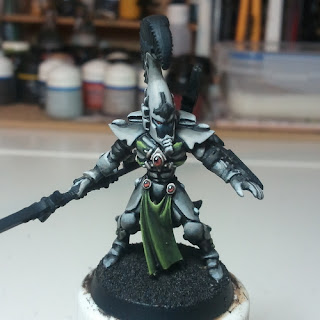Hopefully this isn't too much like preaching to the converted, but someone asked and I thought I'd share.
I have to admit I thought a wet palette was something elitist, that only the top miniature painters used. However I'd seen enough on the internet to wonder what it did for the average miniature painter and thought I'd give it a go.
These are what I'd been using:
They did the job, but what I'd noticed is how quickly the colours I'd mixed up were drying out. I live in a Victorian terraced house in the UK, not exactly the warmest places in the world at the best of times, and we don't have anything fancy like air-con, but I think I was using about 25% of the paint I'd mixed up on the model(s) before it dried out on the palette. This seemed like a colossal waste of paint to me, so it was time to try out this fancy wet palette thing.
(NB: The design of my wet palette is not my own, I borrowed it from another blog and I can't remember the link, so apologies to whoever it was who published it.)
I got myself an air-tight container (from Sainsburys I think) - specifically
this one. It's about 6" square, which I figured for a first attempt was about big enough. I filled it half full with water saturated folded up kitchen roll (making sure I tipped out any excess water - was this important? I have no idea...), cut out a piece of white (silicon based?) baking paper and pressed it down on to the kitchen roll.
That's it.
Nothing fancy, 1 shallow plastic tub (and you could use one a lot cheaper than mine, probably best if it's water/air tight though), some kitchen roll, and some baking paper. Mine looks like this (sans lid obviously):
The paint on the paper there is still wet, the small amount of Bronze having been mixed up the night before. On a standard tile that would have been dry in 5 minutes or less. I think I use up 50-75% of the paint I mix up now, possibly more. Which in itself is reason enough to use it! I wouldn't say that it makes me a better painter, but it does make it much easier to paint to the best of my ability. It saves both paint and time, and it allows me to mix up a "set" of highlight colours, that I can use one after the other without interruption, and go back if something needs touching up. In my experience it also rewards thinning your paints more than you usually would too.
It removes a lot of unnecessary frustration and stress (having to continually mix paints is frustrating for me), and makes painting a much more fun experience.
So there we are - wet palettes, not just for professionals! Any questions give me a yell. I'll do an update in a week or so on anything I've noticed using it.
In other news, Lucius the Eternal is finished (pictures in a couple of days). I've got a new colour scheme for the Dire Avengers, as the dark brown didn't hit the spot for me, and I'm about to start on a Wood Elf lord with great weapon. I'm probably going to start my first Warmachine miniature too - might give Sorcha (sp?) a go...










